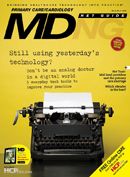On the Home Front: New Standards for Patient-centered Medical Homes Unveiled
The field will move forward, but issues with interpreting data are still a challenge
The field will move forward, but issues with interpreting data are still a challenge.
The patient-centered medical home (PCMH) is a model of care emphasizing care coordination and communication. Research shows that medical homes can increase quality, lower costs, and improve patients’ and providers’ reported experiences of care.
Since it first emerged a few years ago, the PCMH concept has been constantly evolving. Another step in that process took place at the end of January, when the National Committee for Quality Assurance (NCQA) released new PCMH standards calling for medical practices to become more patient centered. They also reinforce federal “meaningful use” incentives for primary care practices to adopt health information technology. “PCMH 2011 advances the patient-centered medical home as a paragon of 21st-century primary care … By emphasizing access, health information technology, and partnerships between clinicians and patients to improve health, these new standards raise the bar in defining high-quality care,” said NCQA President Margaret E. O’Kane (http://HCP.LV/fVYGEn).
Enhancing care coordination
Susan Edgman-Levitan, PA, leader of the 22-member advisory committee that helped NCQA create PCMH 2011, said the new standards will “enhance care coordination, clinician and staff satisfaction, and primary care quality nationwide, while putting patients in the driver’s seat to manage their health.” Edgman-Levitan is executive director of the Stoeckle Center for Primary Care Innovation at Massachusetts General Hospital.
The new standards mark the debut of the next generation of the NCQA recognition program that designates high-quality primary care practices as patient-centered medical homes. According to NCQA, the PCMH program is its fastest-growing service, with a 3,400% increase in recognized clinicians and a 5,200% increase in recognized sites since 2008. In addition, by the end of last year, almost 7,700 clinicians at more than 1,500 sites across America had received NCQA Recognition as patient-centered medical homes.
What’s new?
PCMH 2011 directs practices to organize care according to patients’ preferences and needs. The new standards emphasize:
• access to care during and after office hours
• managing care in collaboration with patients and families
• providing services in patients’ preferred languages
• helping patients with self-care
• facilitating patient access to community resources
To support patient-centered care for children, PCMH 2011 standards include parental decision making, teen privacy, and guardianship. Standards also cover communication between medical facilities about newborns’ lab results and guidelines for planning the transition from pediatric to adult care.
Emphasis on patient feedback in PCMH 2011 supports what is widely known as the “triple aim”—improving quality, containing costs, and enhancing the patient experience. NCQA is collaborating with the Agency for Healthcare Research and Quality to develop a medical home version of the Consumer Assessment of Healthcare Providers and Systems (CAHPS) Clinician & Group Survey, a widely used evaluation of patient experience. NCQA expects to release CAHPS for medical homes in the second half of 2011. Starting in January 2012, practices may receive additional NCQA distinction by voluntarily reporting patient experience data.
Interpreting data
According to a briefing paper released in September 2010 by the National Academy for State Health Policy (http://HCP.LV/dIO8Hk), interpreting that data can be problematic. “Sustained financial support for medical home initiatives at both the state and federal level is ultimately contingent on the ability to show results, making evaluation a priority. Evaluations are consistently designed to measure cost and quality outcomes, and increasingly, provider and patient satisfaction,” authors Michael Stanek and Mary Takach wrote. The goal of the paper was to provide states with information on how claims-based data can be used to evaluate medical homes.
The authors also stated that “Claims offer a readily available and relatively inexpensive source of population-wide data. However, the limitations of claims data make the use of data sources such as patient and provider surveys and EMRs [emergency medical records] a valuable supplement. Evaluators using claims data must grapple with issues of data use, practice attribution, and missing data.”
They went on to note that whatever the data sources used, states need to ensure that evaluation metrics are distinct from the criteria used in the state’s definition of a medical home. If they are too similar, simply meeting the definition of a medical home will ensure a high score in subsequent evaluations.
“NASHP consortium states also expressed concerns that practice participation would be discouraged if evaluation standards were set too high,” the authors wrote. “All of these factors must be weighed when a state is designing an evaluative scheme because each will help determine which kinds of data will be most useful to the evaluator.”
Special Issue on the Patient-centered Medical Home
Family, Systems, & Health dedicated their entire December 2010 issue to research focusing on the integrative, collaborative, patient-centered model of care that is the Medical Home. As the authors write, “This special issue on the Patient-Centered Medical Home (PCMH) reflects its times. At the presenttime, the PCMH is an aspirational model with a few pilots functioning well around the country. How long the current period of idealism, fueled by the energy of early adopters, the consensus of diverse stakeholders, and the dollars of the Affordable Care Act will continue is anybody’s guess. Representing the thinking of some of the best minds in the field, the articles in this issue have an aspirational and idealistic tone as much as a descriptive and analytic one. A year ago the balance would have been tipped more toward idealism and model building and a year from now it would, in all likelihood, tip more toward model description and analysis.”
Web Resources
Dowload the PCMH 2011 standards free of chart at
Advice from the American College of Physicians on implementing PCMH can be found at
A podcast, "The Patient-centered Medical Home: How to Advance Patient Care Through Technology With Jim Stape," can be accessed at
